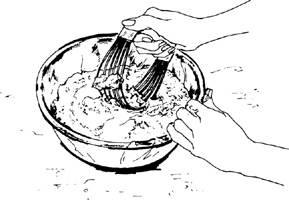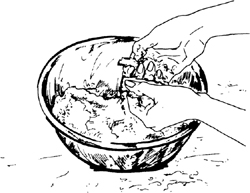Mastering the Art of French Cooking, Volume 2 (54 page)
Read Mastering the Art of French Cooking, Volume 2 Online
Authors: Julia Child

Then roll dough rapidly out into a rectangle 16 to 18 inches long. (Again, if dough is very cold and you have not beaten it sufficiently to soften the butter, the sides may split when you roll out the dough. Do not worry if this happens; remember to beat it a little longer the next time.) Fold rectangle of dough into three, again as though folding a business letter and as diagramed in Turn 1. Rotate dough so top flap is to your right, book-opening fashion; roll again into a rectangle and fold into three. You now have completed the fourth turn, and have 72 layers of butter. With the ball-ends of your fingers, make 4 depression marks in the surface of the dough. Wrap and chill for at least 2 hours to firm the butter and to relax the gluten. It is then ready for forming and baking in any way your recipe directs. (You may, of course,
give the dough 2 more turns after it has chilled, tripling the layer count twice again to a total of 648; this is called for only rarely, however.)
Storage, ahead-of-time notes, and freezing
You may wrap and store
puff pastry dough in the refrigerator at any step during its manufacture; however, remember that if you have not completed 4 turns the butter will be distributed in rather thick layers. Thus if the pastry is very cold, the congealed butter will break into lumps and flakes unless you give it a careful and thorough beating with your rolling pin before you attempt to roll it out. Puff-pastry dough may be frozen for as much as a year, when wrapped airtight and kept at zero degrees or less; thaw at room temperature or overnight in the refrigerator.
Forming and baking the dough—after a rest of 2 hours
A complete listing of recipes using puff pastry is
in the index
.
Use of leftover dough
VARIATION
Pâte Feuilletée Fine
[Classic French Puff Pastry—for
vol-au-vent
, patty shells, fine desserts, and
petits fours
]
Classic French puff pastry has equal amounts of butter and flour, 6 rollings out and foldings, and develops 729 layers of butter sandwiched between 730 layers of dough. You may use it for any recipe requiring puff pastry, but its particular role lies in the realm of the patty shell, the fine dessert, and the elegant tea pastry. As you will see, the dough mixture contains butter rather than oil, and is made like pie dough; rather than being spread on, the main part of the butter is enclosed in the dough. Otherwise the technique for classic puff pastry does not differ too much from simple puff pastry. You must allow, however, a minimum of 6 to 7 hours from the time you start it to the time you can form and bake it. As usual, most of this time is taken up with rest periods; the actual work involved is probably not more than 30 minutes, and this can be spread over a period of several days.
For about 1 pound of flour, making 2½ pounds of dough, enough for one 8-inch vol-au-vent 5 inches high or 8 to 10 patty shells, plus leftovers which will make a 6- by
16-inch covered pastry
, or 2 dozen of
the cheese appetizers
1)
La détrempe—the dough mixture
2¾ cups all-purpose flour and ¾ cup plain bleached cake flour, measured by scooping dry-measure cups into flour and leveling off with a straight-edged knife A 4-quart mixing bowl, or the large bowl of an electric mixer A rubber spatula A ½-cup dry-measure cup (to reserve flour for Step 2) 3 ounces (¾ stick) chilled unsalted butter A 2-foot length of waxed paper | Measure the 2 flours into the mixing bowl and stir thoroughly with rubber spatula to blend. Scoop out ½ cup and reserve for Step 2. Place chilled butter on waxed paper and cut into quarters lengthwise; rapidly cut quarters into ¼-inch pieces and add to the flour in the bowl. The butter is now to be cut into the flour and the liquid then added, just as though you were making pie dough. You may use an electric mixer as described in the |
| or rub the flour and butter rapidly together between the tips of your fingers |
2 tsp salt
1⅛ cups iced water in a 2-cup measure, plus a few droplets more if needed
A plastic bag
Blend the salt into the iced water and pour into the flour and butter mixture. If you are using an electric mixer, mix for just a few seconds, stopping the machine as soon as dough clogs in the blades. Otherwise blend with a rubber spatula, pressing dough firmly into a mass with spatula and then with cupped fingers of one hand. Lift massed dough out onto marble or board; sprinkle unmassed bits in bowl with droplets of water, press together and add to main body of dough.
Press dough firmly and rapidly into a rough cushion shape; consistency should be pliable, though not at all damp and sticky. Sprinkle lightly with flour, wrap in waxed paper, and slide into a plastic bag. Refrigerate for 40 minutes to relax gluten and firm the dough.




